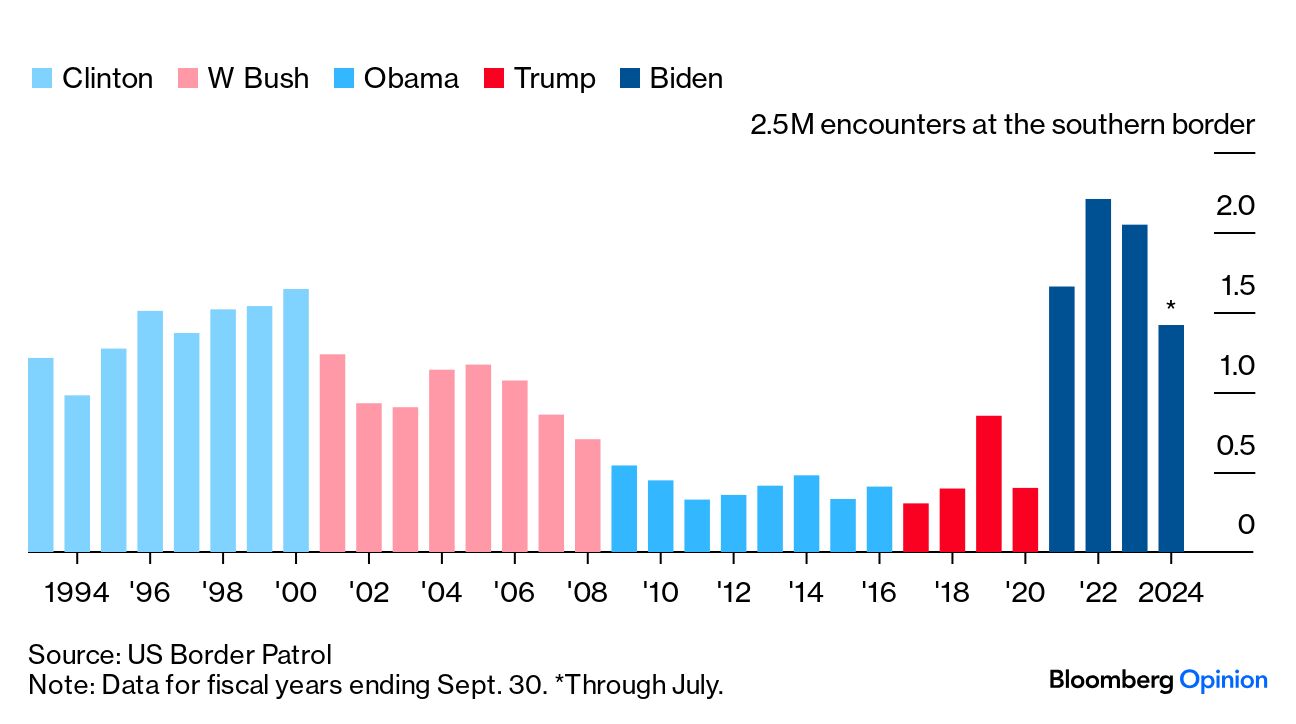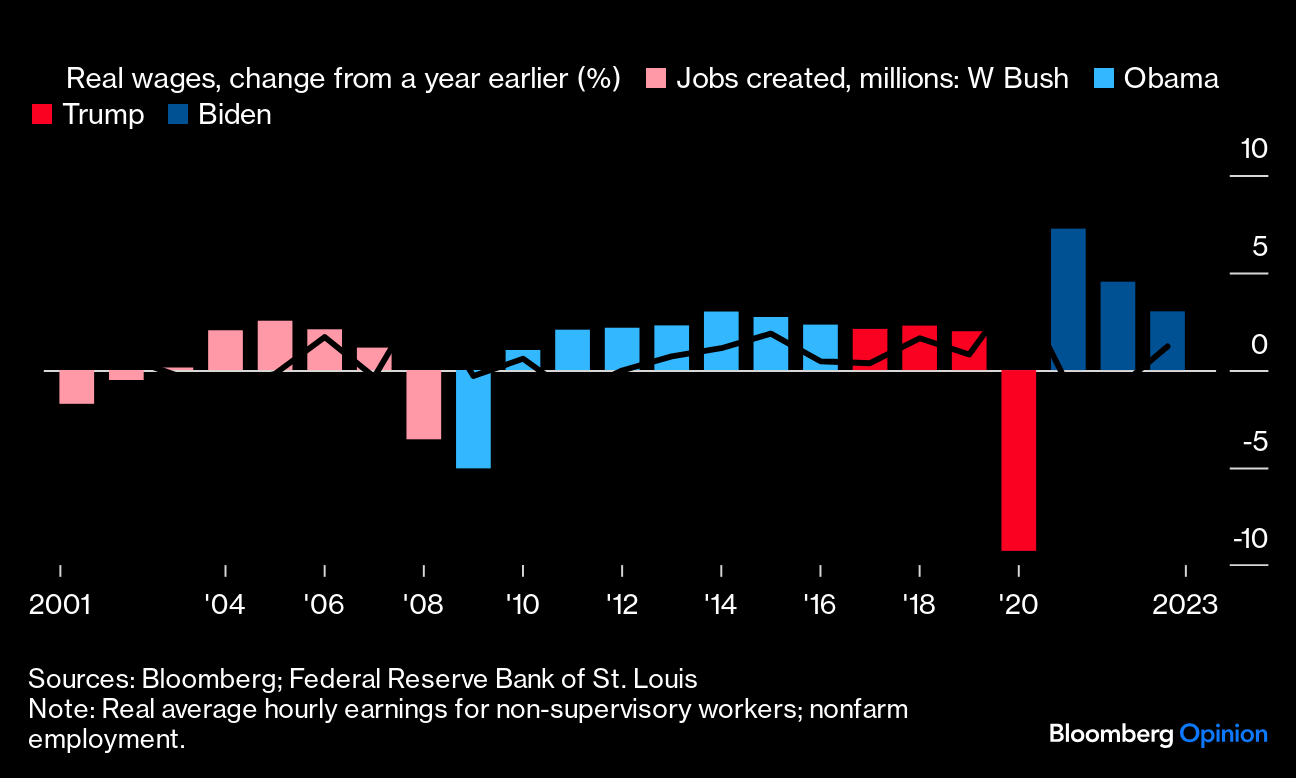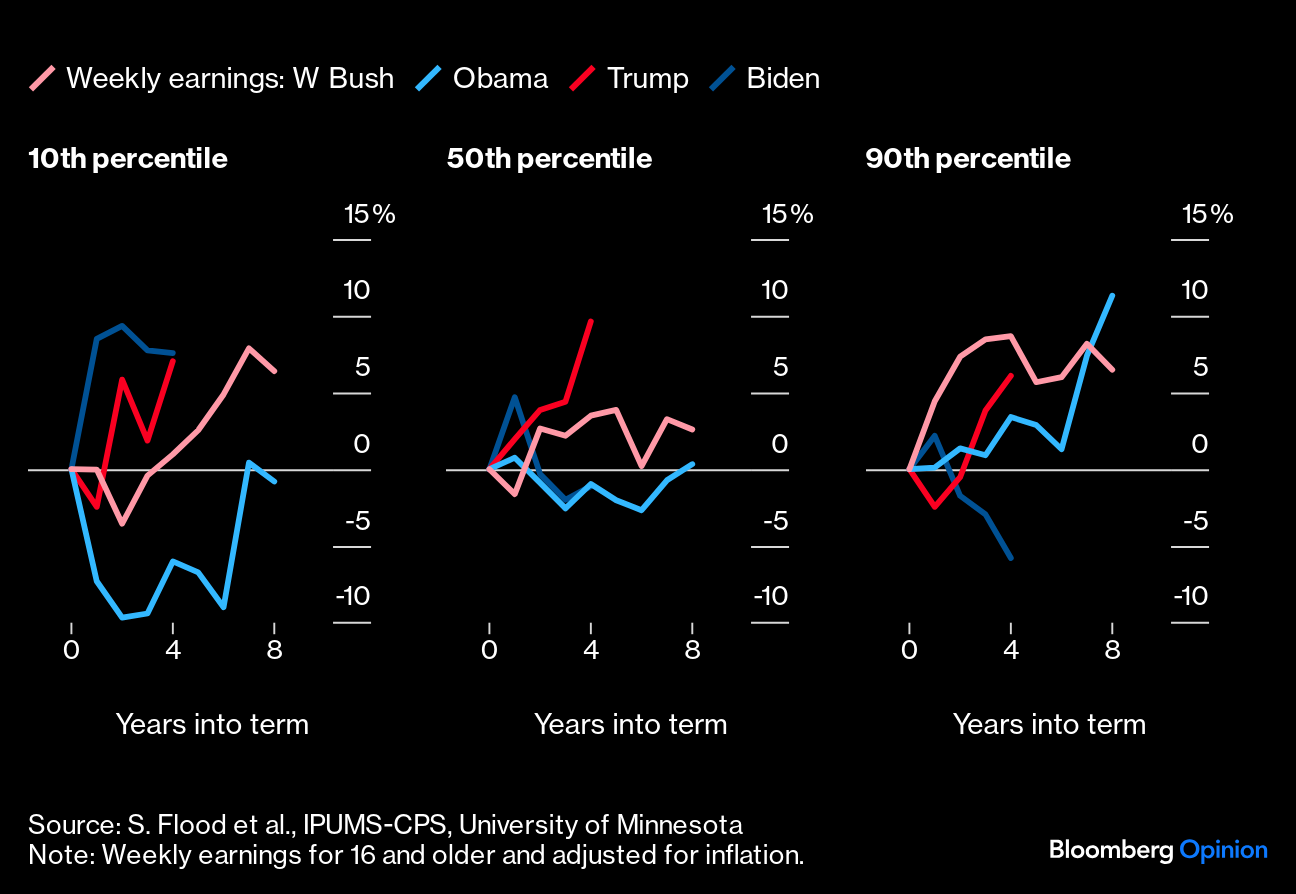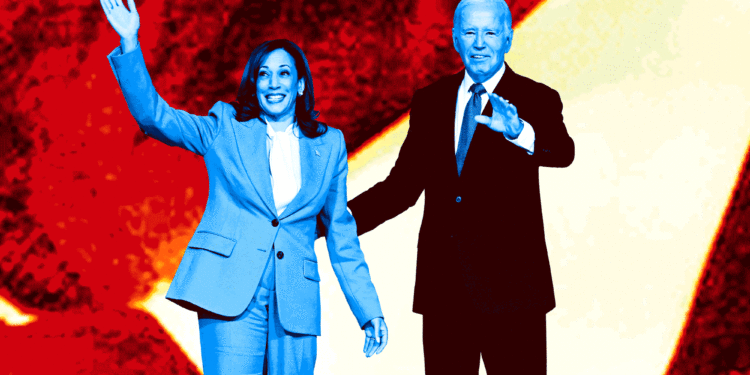
Photo illustration: Elaine He; Victor J. Blue/Bloomberg and Bill Pugliano via Getty Images
Biden — and by extension, Harris — has outperformed Trump on a number of fronts, such as job creation, health care and crime. But not all.
By Bloomberg Opinion Columnists
September 10, 2024, 10:00 AM UTC
In the race between Vice President Kamala Harris and former President Donald Trump, the polls are tight and their policy plans are underwhelming. But there is another way to compare their ability to do the job that gets far too little attention: Both candidates have a record to run on — and the data tell their own story.
Bloomberg Opinion columnists analyzed 10 metrics in March comparing the Biden-Harris administration with Trump-Pence on the economy, immigration, crime and more. A lot has changed since then: President Joe Biden dropped out; Harris and Trump selected running mates and accepted their party’s nominations. In revisiting these metrics, we are seeking to answer questions at the heart of America’s electoral decision in 2024: Was the country better off under the last administration or the current one? And whose plan for the future is backed by past performance?
Immigration limits came too late
Border encounters in July plummeted after an executive order, but the past four years were still record-breaking

Note: Data for fiscal years ending Sept. 30. *Through July. Source: US Border Patrol
 James Gibney
James Gibney
The Biden-Harris administration seemingly put a cork in the immigration bottle with a June executive order that narrows access to asylum and speeds up the removal of those not qualified to enter the US. But it may be too late to deflect criticism after four years of record-breaking migration across the southern border.
More than 8 million encounters between ports of entry have been recorded; more than 1 million foreigners were given temporary admission through targeted parole programs; and the asylum case backlog in the court system nearly doubled.
Southern border encounters

Note: Encounters between ports of entry for fiscal years ending Sept. 30. Source: US Border Patrol
That said, Republican charges that Harris failed as “border czar” conveniently ignore that her actual job was to work with Central American nations to address the root causes of migration — a long-term strategy, not a short-term fix. The recent executive order, meanwhile, reduced the number of encounters with the US Border Patrol in July to about 56,000, the lowest under Biden and below some periods under Trump.
The administration achieved this by curtailing asylum access when the number of migrant encounters exceeds 2,500 a day — a provision that mirrors parts of the bipartisan legislation that Republicans in Congress torpedoed this year at Trump’s behest. Harris has pledged to sign the border security bill into law if she wins, ignoring left-wing criticism that it tramples the rights of migrants to apply for refuge in the US.
You could interpret this as an election-driven pivot, given the hardening of public attitudes toward immigration. But it is also recognition that the broken immigration system requires bipartisan legislation that comes with fiscal resources and is less vulnerable to legal challenges.
Harris’ position seems more reality-based than Trump’s campaign platform: The wall he wants to build from California to Texas amounts to an Ozymandian boondoggle, and his plans to deport the more than 11 million undocumented migrants are morally bankrupt, economically catastrophic and logistically impossible.
Murder rates are falling
Other violent crimes also show widespread declines

Sources: Federal Bureau of Investigation; AH Datalytics estimates for 2023 and 2024, which is through early September
 Justin Fox
Justin Fox
Presidents’ impact on crime rates is limited, but Biden probably deserves some credit for recent declines.
The US was in the midst of its worst spasm of violence in decades when Biden took office, with the homicide rate rising 32% in 2020. Murders started to fall in autumn 2021, and the declines have accelerated since. So far this year, there have been 17% fewer murders in the 277 cities tracked by AH Datalytics than in the same period of 2023. If that decline holds up nationally for the full year, the murder rate will be lower than in 2019.
Homicide rate

Sources: Federal Bureau of Investigation; AH Datalytics estimates for 2023 and 2024, which is through early September
Other violent crimes have followed a more complicated trajectory, and are less reliably measured, but reports from the Federal Bureau of Investigation and Major Cities Chiefs Association show widespread declines last year and so far this year.
What did Biden do? He turned strongly against calls by some Democratic activists to “defund the police,” and his 2021 stimulus included $350 billion in aid to state and local governments that he urged them to spend on law enforcement.
Harris did offer some support to the defund movement in 2020, although as a longtime prosecutor she has mostly been identified with a moderate approach that mixes tough enforcement with sentencing reform. Meanwhile, Trump’s repeated attempts to make crime a top campaign issue keep running into the inconvenient truth that by most measures it was much worse when he left office in January 2021.
Health care coverage hit a record high
Lower drug prices will also save the elderly and taxpayers billions of dollars

Note: Data for 18–64 year olds at the time of interview. Source: National Health Interview Survey
 Lisa Jarvis
Lisa Jarvis
Expanding access to affordable health care is one of Biden’s most indelible legacies, and it’s a priority that Harris has embraced, too.
After inheriting a declining number of people with health coverage, Biden introduced subsidies and tax credits and invested in health care navigators to facilitate enrollment in government plans. By 2023, he had done more than reverse losses accrued during Trump’s tenure: The number of uninsured Americans dropped to 7.2%, an all-time low, leaving about one in 10 working-age people without coverage.
Health insurance status

Note: Data for 18–64 year olds at the time of interview. Source: National Health Interview Survey
The number has crept up a little since then, likely due to the millions who lost access to public insurance when the formal health emergency due to Covid ended. Yet enrollment in plans under the Affordable Care Act, which surged to an all-time high of 21.3 million this year, helped blunt the impact. While Trump pushed to repeal Obamacare as president, he’s been less strident about it as a candidate this year.
Biden’s other big health care legacy will be his success in lowering prescription drug prices for seniors. He capped the price of insulin at $35 per month for people on Medicare and put an annual cap on out-of-pocket costs for prescription drugs. And the Inflation Reduction Act gave Medicare newfound powers to negotiate prices on certain therapies. The administration says the first round of price cuts will save taxpayers some $6 billion and seniors some $1.5 billion in out-of-pocket costs.
Harris plans to pick up where Biden left off. She has proposed bringing the out-of-pocket savings and insulin copay price caps to all Americans, as well as speeding up the timeline for when more drugs are added to Medicare’s negotiation roster. She also plans to cancel medical debt for millions (though has yet to offer details about what that will look like in practice).
Job creation had a record run
Wage growth should outpace inflation if the labor market stays strong

Note: Real average hourly earnings for non-supervisory workers; nonfarm employment. Sources: Bloomberg; Federal Reserve Bank of St. Louis
 Jonathan Levin
Jonathan Levin
The labor market has added 15 million jobs under the Biden-Harris administration, more than any other at a similar stage, despite a preliminary downward revision to the data in August that caused a political stir.
Pay and work

Sources: Bloomberg; Federal Reserve Bank of St. Louis
Put another way, about 81% of the prime working-age population (ages 25–54) has a job, the highest such ratio since 2001. At least some of that is a direct result of government industrial policy, including the CHIPS Act, the Infrastructure Investment and Jobs Act and the Inflation Reduction Act, for which Harris cast the tie-breaking Senate vote.
Wages adjusted for inflation are much less inspiring. In a country that’s used to seeing compensation growth outstrip rising costs, the typical American household has been just about treading water during the Biden-Harris administration, with large nominal wage increases eaten up by major upticks in prices.
That explains why Harris has filled her campaign with populist proposals tackling high rents and what she calls supermarket “price gouging.” While this may be useful campaign rhetoric, it overlooks the fact that inflation, while painful, is already coming down. Instead, she should lean into the administration’s job-creation record, highlighting the high-paying manufacturing jobs already in train from this White House’s policies. With inflation ebbing, workers have a chance to see meaningful real income gains as long as their nominal wages keep rising in a strong labor market.
Lower inflation means rate cuts
Still, high costs for basic goods continue to hurt sentiment

Note: Breakeven data, measure of future inflation expected by Treasury investors, available starting 2004, through Sept. 6. Source: Bloomberg
 Matthew A. Winkler
Matthew A. Winkler
Inflation is closing in on the Federal Reserve’s 2% target after surging to a four-decade high during Biden’s first two years. Voters though still rate it as a top concern, one that Harris has sought to diffuse with her “price gouging” proposal.
Rising prices were supposedly undermining “Bidenomics” when increases in the consumer price index peaked at 9.1% in 2022, according to prevailing media narratives featuring many prominent economists. There’s been an unprecedented moderation in price gains since, with CPI rising 2.9% in July from a year earlier.
Consumer and expected inflation

Note: Note: Breakeven data, measure of future inflation expected by Treasury investors, through Sept. 6. Source: Bloomberg
The resulting disinflation — occurring while gross domestic product expanded 3% last quarter — is unmatched in modern history and the opposite of the 1970s, when inflation took eight years and five months to subside to 3%. It gives policymakers room to begin lowering interest rates this year.
Despite this, Americans largely say they have trouble paying for even the basics because overall prices remain elevated — dissatisfaction that the Trump campaign has capitalized on. Harris’ response envisions something akin to price controls on the most basic of needs — groceries. Most economists doubt such moves would work. But for now, it’s what voters want to hear.
Even as the Fed rapidly raised rates in 2022 and 2023, some $27 trillion of US government securities — a daily gauge of global investor preferences — showed that the inflation spike was little more than a consequence of supply chain disruptions and pandemic shortages.
In June 2022, many said inflation was out of control. But the market for swaps, or derivatives, tied to inflation accurately anticipated CPI to the nearest decimal every month of the year, according to data compiled by Bloomberg. It now signals 2.1% inflation by December and 1.9% a year from now. The breakeven rate showing traders’ expectations for average inflation in the next two years is 1.5%.
Biden is the greenest president in history
After more than half a trillion dollars in energy transition investments, the election will either preserve or undo his legacy

Note: Doesn’t include an average of $82B a year of power grids data, which begin in 2020. Source: BloombergNEF
 Liam Denning
Liam Denning
Biden will leave office definitively as the greenest president in history — but he’s handing off a revolution showing signs of strain to either its potential guardian or its nemesis.
US energy transition spending, excluding that on power-grids, more than doubled by the end of 2023 compared with when Biden entered the White House, according to Bloomberg NEF. Investment in renewable energy, especially, has surged since passage of the Inflation Reduction Act, reaching an annual $100 billion for the first time in the 12 months through June.
Renewable energy investments

Yet cracks are apparent. The pace of spending on the next largest segment, electrified transport, undoubtedly has slowed this year, given weak sales for bellwethers Tesla Inc. and in California. Offshore wind investment, which jumped in 2023, has retreated amid persistently high interest rates.
The Fed should soon offer relief on the rates front. The real bulwark of climate policy, though, is the IRA’s incentives for cleantech projects and products as well as the factories supplying them. The latter are spread nationwide, overwhelmingly in red districts, seeding constituencies supportive for economic, if not necessarily green, reasons — witness the 18 House Republicans warning against repeal of the IRA, which half of them voted against.
Harris has, thus far, been somewhat reticent to discuss climate, perhaps with an eye on Pennsylvania, the only swing state with a significant fossil-fuels sector. (On that front, she can also point to record oil and gas production on her boss’ watch.) More importantly, her job isn’t to pass sweeping new green legislation — Biden did that already — but instead preserve what’s in place as US cleantech supply chains are built. Her opponent, meanwhile, seems hell-bent on tearing it down.
Household wealth is at a record high
Net worth surged under Biden, and sentiment may be catching up

Source: Federal Reserve Bank of St. Louis
 Robert Burgess
Robert Burgess
American families continue to get wealthier and are in better financial shape than at any time since the start of the century. Fed data show household net worth rose to a record $160.8 trillion in the first quarter of 2024, from $131.4 trillion at the end of 2020. That’s a 22% increase, dwarfing the 17% gain at the same point in the Trump administration.
The surge in wealth has an underappreciated benefit: Household debt fell to 97% of disposable income as of the end of March, the lowest outside a pandemic year since 2001.
Household wealth

Source: Federal Reserve Bank of St. Louis
Yet the consensus has been that the economy is a negative for the Biden-Harris administration because consumer sentiment measures remain below pre-pandemic levels. Observers say that mostly reflects the toll of inflation, which has left everyday items such as groceries costing more than before the onset of Covid. Then there’s housing, which is the least affordable on record, locking out potential homeowners and making current ones feel trapped.
But times may be changing. In a recent Financial Times survey, Harris was viewed more favorably on the economy than Trump, the first time in nearly a year the Democratic candidate took the lead in the poll. Her economic agenda may deliver more converts. For many Americans, financial wealth and stability start with homeownership. Harris proposes to help in this area by providing as much as $25,000 to those buying for the first time and by dangling tax incentives to developers to address a dearth in housing supply.
Trump has said he would tackle the problem by creating the conditions to bring mortgage rates down to 3% or lower and opening up federal land to housing construction. Project 2025, which aims to influence his agenda, has proposed letting investors and developers decide where and how much supply to add.
Markets answer to no president
Still, the risks to bonds from spending plans are clear

Note: As of Sept. 6 based on monthly compounding. Source: Bloomberg
 Nir Kaissar
Nir Kaissar
Presidents love to take credit for a booming market and disavow a sagging one. The truth is they have little to do with either.
Still, some policies are better for asset prices than others, even if it’s difficult to quantify how much. Trump wants to extend the 2017 tax cuts and lower corporate taxes, which could boost spending and corporate earnings, pushing stocks higher. On the flipside, his proposed tariffs could hurt companies, particularly if US multinationals face retaliatory levies.
Performance

Note: As of Sept. 6 based on monthly compounding. Source: Bloomberg
Harris wants to raise corporate taxes and steer that money to workers and families as tax credits and support for first-time homebuyers. Companies would presumably be worse off from higher taxes, although putting money in consumers’ pockets is generally good for business. The risk for fixed income is clearer: Both Harris and Trump’s proposals are likely to result in higher deficits and debt, which could stoke inflation and force the Fed to raise rates, giving bonds a whacking.
Most likely, though, what drives markets will have little to do with these plans.
Consider the last four White House occupants. George W. Bush inherited the dotcom bubble; stocks were bound to disappoint. Barack Obama inherited a market beaten down by the financial crisis, and the only way forward was up.
Trump slammed into a global pandemic while Biden ran into the biggest selloff in technology stocks since the dotcom crash. The result is similar: The S&P 500 Index has posted a cumulative return of 54% during Biden’s term through Sept. 6, including dividends; compared with 59% for Trump through the end of September in the final year of his term. Flip a coin.
Narrowing inequality hasn’t really mattered
Lower-income workers have seen some gains in real wages, but inflation still stings

Note: Weekly earnings for 16 and older and adjusted for inflation. Source: S. Flood et al., IPUMS-CPS, University of Minnesota
 Allison Schrager
Allison Schrager
Income inequality has narrowed under Biden — even though, when adjusted for inflation, most Americans are only now recovering the ground lost in the early years of his administration while high earners remain worse off.
Biden’s tenure coincided with the reversal of a decades-long trend of most wage gains going to the highest earners. In the past four years, lower-income workers had a few years with real wage gains, while median and higher earners saw small increases or declines.
Income gap

Note: Weekly earnings for 16 and older and adjusted for inflation. Source: S. Flood et al., IPUMS-CPS, University of Minnesota
Wages for the bottom 10% rose 1% between March 2021 and March 2022, while they fell for everyone else. In 2023, real wages were mostly flat compared with the year before. In the year ending March 31, as inflation moderated, real wages grew slightly for middle earners and were flat for those on lower incomes. The glaring exception was the top 10%, who saw further declines.
More Americans will hopefully see wages outpace price increases as inflation continues to ease. The slow progress so far helps explain the dissatisfaction with the Biden economy.
Since the presidency of George W. Bush, Trump has been the only president to preside over positive real wage growth for all groups — but inequality continued to rise as wages for high earners outpaced the bottom 10%.
What happens next will depend on factors such as growth and inflation. A weakening labor market would slow wage growth. If inflation returns because of Harris’ higher spending plans or Trump’s tariff proposals, real wages will probably fall for all groups. A recession would almost certainly widen inequality since lower-income workers tend to be hit hardest.
Harris is more popular than Biden
The vice president’s selection as nominee makes this a close election

Note: Data are 30-day trailing averages. Source: Gallup
 Nia-Malika Henderson
Nia-Malika Henderson
Biden is an unpopular president. Even as millions of jobs were created under his watch and the stock market soared, his approval numbers have stayed near historical lows.
One move made him more popular: His decision to exit the race for reelection. That boosted his job approval rating by seven points to 43%, according to Gallup, still below the standing of any previous president on record who successfully sought a second term. Such stubbornly low numbers explain why he will be a one-term president.
This brings us to Harris.
Favorability

Source: Real Clear Politics via Bloomberg
Harris’ job approval rating has improved among Democrats and all-important independents since she became the nominee, according to Gallup. Overall, she has climbed from 40% in December to 47% in the latest August poll, near levels of incumbent presidents who have won reelection. And Democrats haven’t been this enthusiastic since Obama ran in 2008. Harris, however, is a quasi-incumbent — she’s a sitting vice president, running on a very compressed timeline.
Head-to-head match-ups with Trump show her in a much more competitive position than Biden. Currently, her favorability rating is higher than her predecessor and her competition — she stands at 47%, with Biden at 41% and Trump at 44%.
Going forward, voter perceptions will hinge on her handling of major campaign events, and her position on issues such as immigration, crime and the economy, plus the Israel-Hamas conflict on the international front.
More On Bloomberg
Source link : https://www.bloomberg.com/graphics/2024-opinion-biden-harris-accomplishment-data/
Author :
Publish date : 2024-09-09 23:00:00
Copyright for syndicated content belongs to the linked Source.









